A marine spotlight, as opposed to a floodlight or flashlight, must sufficiently illuminate an object at a considerable distance. Clearly seeing navigation aids, mooring balls, floating debris, breaking surf, or a man overboard require a dependable device with a bright beam of light, one that can be kept at the ready.
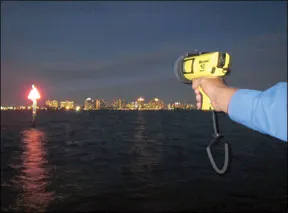
It seems all lights are moving rapidly away from Thomas Edisons incandescent bulbs, but even light-emitting diode (LED) technology is continually evolving. The best marine spotlights combine this improved LED technology with sufficient power, a quality reflector lens, single-hand ergonomics, quick re-charging times, and a rugged durability that includes withstanding submersion. Variables in brightness will depend on the LED(s) used and the electronics that power the LED. Most operate on 6 volts, use rechargeable or standard replaceable C or D cells, or operate direct from a boats 12-volt system. The beam will depend on the engineering contour and reflection of the parabolic reflector.
Since we last tested marine LED spotlights in January 2012, some new products have come on the market and others were improved. With this evaluation, we wanted to update our 2012 test by taking a look at the newcomers and comparing them to our favorites from last years test.
What We Tested
For this test, Practical Sailor evaluated seven LED spotlights, including three from our previous test that were used for comparison, the 2012 Best Choice Streamlight Fire Vulcan, the Budget Buy Coleman CPX6, and the Recommended Streamlight Waypoint.
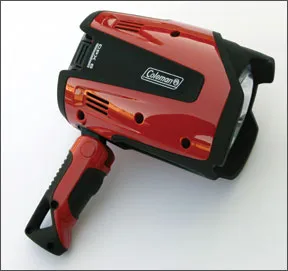
Coleman is a major supplier of camping equipment and offers a wide line of lighting devices. The CPX6 is inexpensive and has the advantage of coming with both a rechargeable and a regular battery pack.
Streamlight markets a large array of powerful, heavy-duty spotlights and lanterns for the military, fire, and police departments, plus commercial and fishing vessels. The Fire Vulcan LED was the most rugged test light, but it was also the most expensive. Streamlight followed up the original Waypoint Alkaline, which we recommended in 2012, with an upgraded version, the Waypoint Rechargeable 44910, that comes with a rechargeable lithium-ion battery.
Along with the new Waypoint Rechargeable, we tested three new West Marine spotlights that were released after our last review. In 2012, we reported some problems with the West Marine LED SuperSpot we tested. Since then, the California-based marine retail giant has completely re-engineered the line. We tested the West Marine 311, 329, and 337 models.
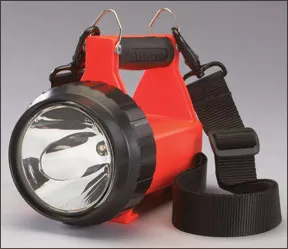
All of the LED spotlights we tested can be used cordless, and most used rechargeable batteries and came with both a 110-volt AC plug-in adaptor and a 12-volt DC cigarette plug adaptor for charging. Only the Waypoint Akaline and the West Marine 337 used standard replaceable C batteries.
All the test lights had a single LED, except the West Marine 311, which used three LEDs. All manufacturers claim that the LEDs are shockproof, waterproof, and will realistically last a lifetime.
Two of the test units were rated only as water-resistant, and the five waterproof spotlights also float.
Coleman CPX6
The Coleman CPX6 (200000 6664) uses a rechargeable 6-volt or four D-cell battery pack. Our test unit came with both and also included both 110-volt AC and 12-volt DC chargers and cords.
The CPX6 has one Cree XP-G LED and a 2.75-inch lens encased in a plastic housing with rubberized edges and a hinged pistol-grip handle with a built-in trigger. The hinged handle has a thumb switch that allows setting and locking the angle in multiple positions.
The CPX6 produced a good illumination beam in tests. However, it is just water resistant, not waterproof, and did not seem to be as rugged as other test products. PS testers were not impressed with the ergonomics and balance of the CPXs hinged handle.
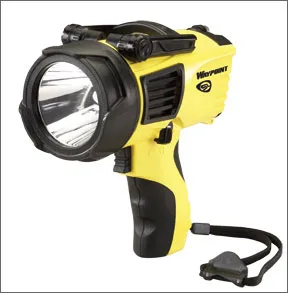
Bottom line: Although the CPX6 has the advantage of using both rechargeable and replaceable batteries and it was the least expensive light in the test, it was held back by concerns over its durability. It was eclipsed by the other test lights.
Streamlight Fire Vulcan Led
The Fire Vulcan LED (44450) looks like a small red brick with a handle and two top-mounted D-rings for the carrying strap. It is waterproof to IPX7 standards (submersible to 3 feet for 30 minutes), has hazardous-area classifications, and will float. It comes with a rugged shoulder strap with a quick-release snap button; new generation, rechargeable lithium-ion batteries; one C4 LED; and both 120-volt AC and 12-volt DC charging adaptors.
The Fire Vulcan tied with the Waypoint Rechargeable for the top spot in the brightness test, notching the highest lux measurement of the test field. It landed in the middle of the pack in the service life test, lasting 2 hours before reaching half-power, but it took 5 hours to recharge, the longest recharge time of the test lights.
Designed with fire and police servicemen in mind, the Fire Vulcan has two blue locator lights on its back so people behind the user can locate them (think smoke or fog).
There are eight user-programmable functions for the on/off switch located below the carrying handle. Pushing the switch left or right controls the modes for the spotlight or rear lights (high, low, flash, or off).
Some testers found the Fire Vulcan to be one of the least ergonomic lights in the test, with its handle mounted on top rather than in a pistol-grip style.
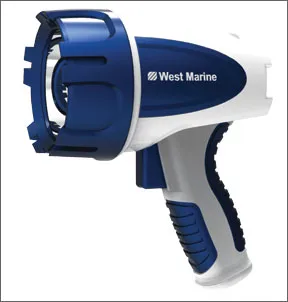
The spotlight also comes with a plastic desk or wall-mount stand for recharging or storage. With lithium-ion batteries, you can leave the device in the charger anytime it is not in use.
Bottom line: Although testers favored the Waypoint Rechargeable overall, the Fire Vulcan earned PSs Recommendation for its unique features, rugged durability, and top-notch performance
Streamlight Waypoint
The original, alkaline Streamlight Waypoint is a lightweight pistol-grip spotlight that uses a C4 LED and has a 2.4-inch lens and yellow (or black), high-impact polycarbonate housing that is rated IPX4 water resistant (can tolerate splashes, not submersion).
This model is not rechargeable; it uses four standard alkaline C batteries, and comes with a 12-volt cigarette plug and 7-foot cord that can be plugged into the bottom of the grip. Running on the alkaline C batteries, it lasted an impressive 5 hours before decreasing to half-power, the longest run time in the test.
The Waypoint tied the West Marine 329 for second place in the brightness tests, and testers rated it Excellent for illuminance and ergonomics.
Both Waypoint models come with a handy wall-mount storage holster that uses Velcro to hold it in place and a unique, integrated stand that can be used to position the light for hands-free illumination; the stand folds down flush on top when not being used. The side has a thumb switch to control the mode of the on/off trigger function: high, low, and SOS flash. The batteries are accessed by a hinged door on the back, held with a thumb screw that can be tightened with a convenient screw driver built into the end of the wrist lanyard.
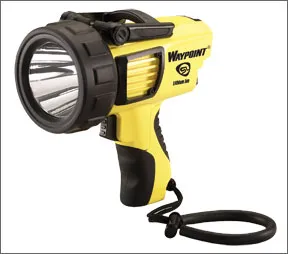
Streamlight has a limited lifetime warranty on its spotlights cases and a two-year warranty on batteries, switches, and electronics.
Bottom line: This unit is rugged, produced a very white, narrow beam, and is well balanced with the pistol grip and easy-to-use trigger. PS testers liked this spotlight in 2012, and we still Recommend it for those looking for a 12-volt plug-in spotlight.
Streamlight Waypoint Rechargeable
The new Streamlight Waypoint Rechargeable (44910) looks very similar to the alkaline model, but it is more lightweight and features some major refinements. It uses the same C4 LED but has a slightly larger lens and a wider beam. Its most notable difference is that it uses rechargeable lithium-ion batteries rather than alkaline.
The Waypoint Rechargeable was just behind its predecessor in lux measurement but it actually had one of the brightest beams in the test field. It lasted 4 hours before reaching half-power operation, and it required only 2 hours to fully recharge-the shortest recharge time in the test. A small LED denotes charging status. Although the other lights felt a little warm when left on, this Waypoint was noticeably cool even after four hours on.
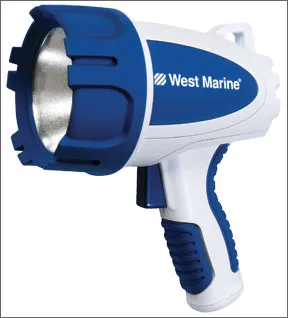
The rechargeable Waypoint also features the same fold-up tripod stand and wall-mount holster as the older Waypoint, but the high-impact pistol-grip case has been modified to make it IPX8 waterproof (submersible to 6 feet for longer than 30 minutes) and able to float.
Stainless steel rings have been added for the clip-on shoulder strap, and the mode switch was moved to the back, out of the way, and the wrist lanyard has an adjustable toggle to tighten it.
Testers also noted another nice feature: You can depress the trigger switch part way for quick signals, for brief illumination or to send Morse code. Pressing it fully leaves the light on. The mode switch on the back selects a low light or a continuous blinking. A small tethered plug that has a unique twist-lock operation covers the charger connection hole.
Bottom line: At $120, the Waypoint Rechargeable was the most expensive in the test; however, its top-notch performance, rugged durability, and bonus features make it a worthwhile expense, in our opinion. It gets PSs Best Choice.
West Marine 311
All three West Marine lights are pistol grip-style with rubberized lens protectors and handles, and shatterproof polycarbonate lenses, and all have wrist lanyards. All are submersible to 3 feet for 30 minutes, and all will float face up. All are a definite improvement over the West Marine lights in our 2012 evaluation. They all are ergonomically pleasant to hold, easy to use, and have good trigger action.
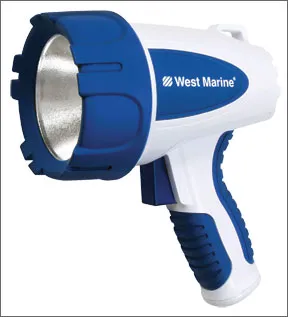
The 311 is the largest spotlight in West Marines 12972 series. It has a 4-inch lens, three LEDs, and three light settings (high, low, and SOS flashing). The light comes with rechargeable alkaline batteries and includes both a 110-volt AC and a 12-volt DC cigarette-lighter cord and charger. A 1-inch, untethered plastic plug in the lights back allows access to the power socket; according to West Marine, future production models of the 12972 series will have a tether to the plug so losing it wont be a concern.
A red LED indicates battery charge status. West Marine does not recommend always leaving it plugged in, as it might overcharge.
The 311 ranked fourth in spot brightness and measured about half the lux of the Fire Vulcan. Of the three West Marine products, it produced the most light, but it did not have a narrow spot beam. At one-fifth of a mile, its illuminance matched the other lights in the test field, but its service life was the shortest of the bunch.
The 311 was the largest and heaviest test light, but its pistol-grip design made it easy to hold and use. It comes with a one-year warranty, as do all of the West Marine spotlights in the test.
Bottom line: The $100 West Marine 311 is worth considering if youre looking for a spotlight that offers a floodlight effect, but wed rather spend the extra $20 for the rechargeable Waypoint.
West Marine 329
The West Marine 12972 329, with a 3-inch lens and only one LED, is a smaller and lighter version of the 311. Like its big brother, the 329 is powered by rechargeable alkaline batteries, and it also has both 110-volt AC and 12-volt DC chargers and cords, and a 1-inch plastic cap over its power access. The trigger switch controls high, low, and SOS modes, and a red LED indicates charging status.
PS testers were impressed with the construction and functional improvements in all three of the new West Marines lights, but the 329 bested its siblings in spotlight brightness, and it offers a good beam pattern. It lasted 1 hours before depowering to half, but it required over 4 hours to fully recharge.
The 329 was the only test unit that had issues during submersion testing. After the test, we found that there was water inside the light, visible through the lens, even though the screw-in plug was tight. Testers opened it up, dried it out, and put it back in the water. Once its innards dried out, the light continued to work, and this time, there was no leak. We assumed that the problem was the O-ring behind the screw-on cap for the power plug; if it is not seated well, water can seep in behind the cap.
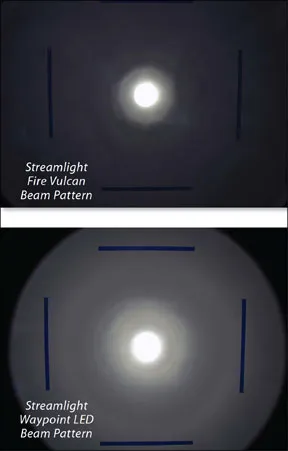
According to West Marine, no other users have reported a leaking problem, but the company agreed that a dislodged O-ring would cause leaking, even if the cap is screwed on tightly.
Another hiccup testers had with the 329 resulted in an accidentally severed LED wire. If you remove the spotlight lens-which West Marine does not recommend doing-be sure to re-align the reflector with the knob and slot before screwing down the lens cover. As we found out the hard way, if the reflector is not seated properly, it can turn and break the LED lead wire.
Bottom line: A mid-sized and mid-priced spotlight, the 329 is easy to use and well-balanced. It puts out a lot of light, and has an excellent narrow beam of light. It is Recommended, but we advise users to be careful when screwing on the power cap.
West Marine 337
West Marines 12972 337 model uses three regular C batteries, has one LED, and is slightly smaller than the 329. Like its sibling, it has a 3-inch lens, but it has fewer light modes (no SOS). The battery compartment is accessed via the rubberized, screw-on lens cover, which can be very tight. After inserting the batteries, you snap a door closed and re-screw the lens. No wires to worry about, and no battery cap O-ring that can leak.
The 337 was in the middle of the spot brightness spectrum, and its beam pattern was a bit larger than the 329. The 337 light ran for three hours before reaching half power.
Bottom line: The 337 was an average performer, but its compactness, ergonomics, simplicity, and low $40 price earn it the PS Budget Buy.
Conclusions
A good reliable spotlight gives peace of mind on a moonless night. It can allow you to extend a pleasant daysail into the evening, and it gives you confidence that you will see the channel markers, make the right turn into an inlet, or spot your mooring. But which spotlight is best for you depends on the kind and size boat you have, and how and when you use it.
Any one of the spotlights we tested would be better than none, but after evaluating all of them, Practical Sailor gave the Best Choice nod to Streamlights dependable, rechargeable Waypoint (44910), recognizing its long list of preferred qualities: durable, ergonomic, long-lasting and rechargeable batteries, very bright and compact spot beam, and lifetime warranty-not to mention its multiple functions and bonus features.
The downside of the new Waypoint is its high price. If you are a cruiser, have a larger boat, and are often out at night, then its worth investing in a top-of-the line rechargeable spotlight such as the Waypoint rechargeable. However if you sail a smaller boat and are only occasionally sailing at night, then go with what matches your budget and power preferences. The original Waypoint, West Marine 329, and the PS Budget Buy West Marine 337 would all be practical choices.
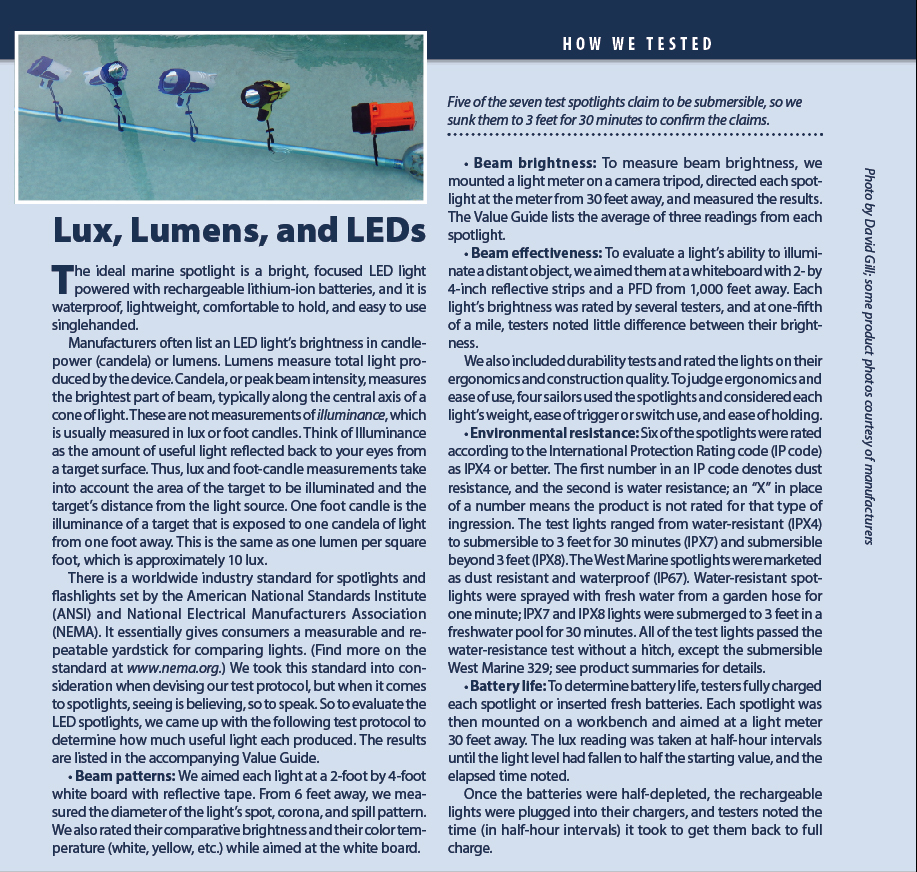
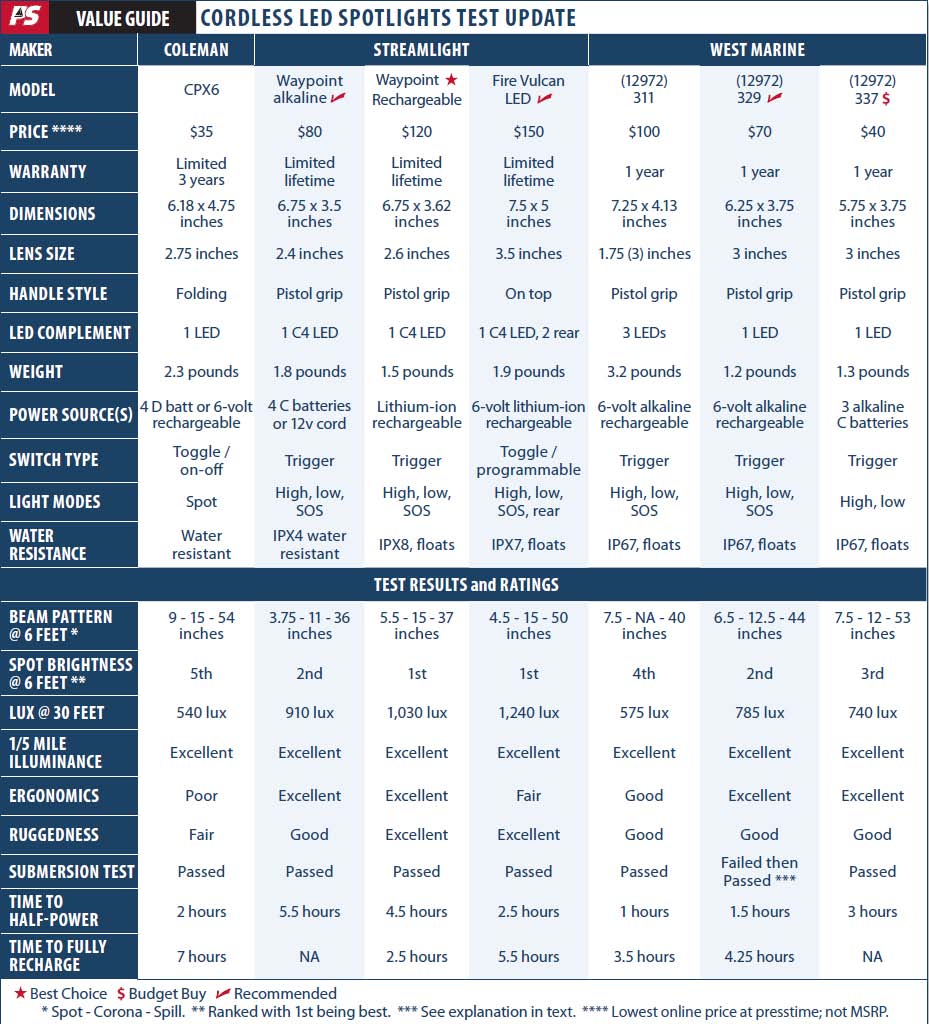






































Thanks for your reviews. I bought Streamlight Waypoint Spotlights for a while, aside from having water-resistant properties, this spotlight is lightweight and can float in water. I also like the trigger-style switch which I found very unique while the secondary switch will select the different light output mode.
I used BIGSUN Q953 and it was good too. What impresses me the most in this spotlight is its toughness and durability. Upon inspection, it looks so tough and hard with the ABS construction and aluminum materials. In terms of the quality of its light, I can say that this spotlight is amazing. It can be used as a spotlight and a floodlight and has the ability to as high as 6000 lumens and can cover as high as 800 meters in distance.
I recently bought a Streamlight spotlight, very satisfied with it. The light is great. Easy to handle, the light is very bright, and the battery lasts a long time.
It’s smart to choose one that is designed for rugged use. Apart from being waterproof, it should be able to withstand impacts, dents, scratches, and bumps. If a marine spotlight for boats is built to last, it can withstand bad weather conditions and harsh environments.